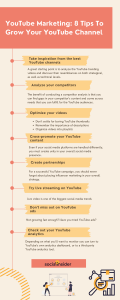
Video is one of the most powerful and most underused tools in a company’s toolbox. It has the unprecedented ability to increase viewer engagement, increase time on site, and ultimately boost conversion on your website. But creating a start-to-finish strategy for online video promotion can be a huge task, especially if you aren’t super familiar with the ins and outs of the video production process. We’ve compiled a list of all the things that you need to consider to get your video promotions off the ground.
Step One: Define a Specific and Attainable Goal
Many companies are tempted to create a video because “we just need a video.” And while having a video is much better than not having one, if you are going to go through all the effort to create a video, it really helps to have specific goals that you want to accomplish with that video. Here are a few examples of specific, attainable goals that you might want to focus on for your videos:
- Increase Donations by 15% by the End of the Year
- Increase Time on Site by 25 Seconds and Maintain for 6 Months
- Increase Conversion Rate on a Landing Page by 45%
- Boost Event Enrollment by 50%
Step Two: Create a Project Scope and Find a Video Production Company
When creating a video project, it’s important to have a clear scope of work. Once you have defined your goals, use those goals to help guide you towards who to include in your video. Remember that to meet your goals, your company’s leaders and business owners might not be the best spokespeople.
You may want to reach out to your video production company to help you think of creative ideas that are outside of the box, but as a general rule, look for your company’s best stories, not necessarily the most well-spoken or highest-ranking person that you can book. A video production company should be able to help you get a really good idea of the cost of your video project based on the goals and project scope.
PRO TIP: Many companies think that the only way to engage with a video production company is to pay for one, highly-produced longer video, but it can often be more cost effective to create a bunch of smaller, digestible, short videos that you can use in more places on your website.
Step Three: Create a Website Distribution Plan
It’s important to know how you plan on using the video on your own site. Are you going to use it on multiple pages or just a single page? Would you like to use a lightbox that pops up over the page or would you like to use the video inline with your text? Don’t just create a video and randomly place it on every page of your website. Try to identify pages where you can put the video above the fold to increase view rates, use your video on pages with conversion opportunities as a way to increase submissions. Think about these other ways to use video on your website:
- Use the video as a foundation point for a new blog post
- Create a splash page centered around the video and send it out to your database in an email blast
- Use video in your content sidebars to captivate a new audience
- Use shorter clips that match up to other existing pages on your website
PRO TIP: Think through what video player you want to use on your website. While YouTube is the king and it’s important to put a copy of your video there to take advantage of its search bar, there are several factors that make other players better for hosting videos on your website.
Step Four: Think About Distribution Beyond Your Own Website
Once you’ve gone through the process of creating a great, story-driven video that will help you accomplish your goals, don’t stop at putting it on your website. If you create an engaging, interesting story, there will often be other channels, news organizations, business blogs, and industry websites that would want to pick up the story.
- Create specific posts on other blogging platforms like LinkedIn Pulse or Medium
- Create a video retargeting campaign
- Launch the video on Facebook or Twitter
- Boost the post or create a sponsored ad to increase your reach
- Write a guest blog for another website and include your video
Step Five: Analyze, Iterate, and Repeat
Creating a great video project is not the end of the line. It’s really important to take the time to look at the results of what you’ve created. Make sure you measure your project against the goals that you set at the beginning. Analyze the results in your video player and look at stats like view vs. play rate, watch rate, CTA click-through rate, etc. Look for areas in the video where users dropped off from watching the video, look for channels where your video was especially successful, and look for ways to capitalize on the lessons you learned during your video project.
Once you’ve taken the time to understand what worked and didn’t work for this video project, think about ways to iterate and change those results in future projects. Once you feel like you’ve learned some things, set new goals and start again — this time even smarter!
Digital & Social Articles on Business 2 Community(87)
Report Post







